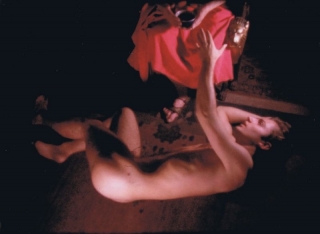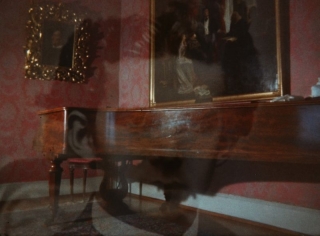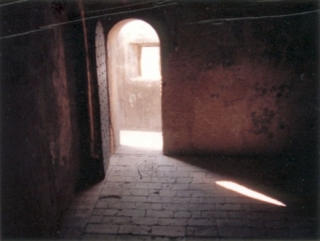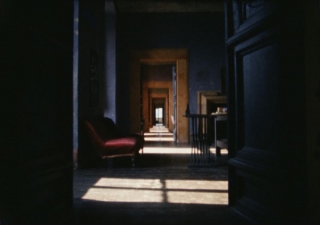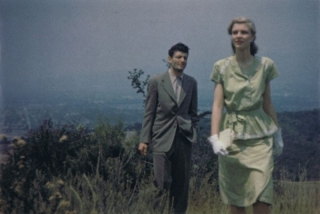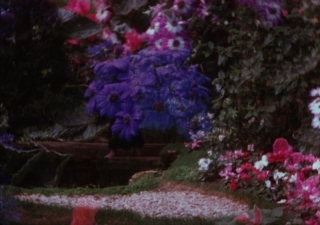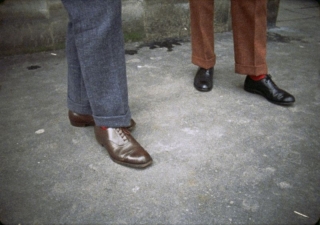Date: 22 March 2015 | Season: Gregory Markopoulos: Film as Film | Tags: Gregory Markopoulos
THE ILLIAC PASSION
Sunday 22 March 2015, at 7:30pm
Los Angeles Filmforum
Throughout his life, Markopoulos remained closely connected to his heritage and made many works that connected with ancient Greek culture. The Illiac Passion, one of his most highly acclaimed films, is a visionary interpretation of ‘Prometheus Bound’ starring mythical beings from the 1960s underground. The cast includes Jack Smith, Taylor Mead, Beverly Grant, Gregory Battcock and Gerard Malanga, and Andy Warhol appears as Poseidon riding an exercise bike. The extraordinary soundtrack of this re-imagining of the classical realm features a fractured reading (by the filmmaker) of Henry Thoreau’s translation of the Aeschylus text and excerpts from Bartók’s Cantata Profana. Writing about this erotic odyssey, Markopoulos asserted that, “the players become but the molecules of the nude protagonist, gyrating and struggling, all in love, bound and unbound, from situation to situation in the vast sea of emotion.”
Gregory J. Markopoulos, The Illiac Passion, 1964-67, USA, 16mm, color, sound, 91 min
PROGRAMME NOTES
THE ILLIAC PASSION
Sunday 22 March 2015, at 7:30pm
Los Angeles Filmforum
THE ILLIAC PASSION
Gregory J. Markopoulos, USA, 1964-67, 16mm, sound, colour, 92 minutes
“Metamorphosis of the filmmaker. Passions of the filmmaker. Out of his breast the free flowing blood of the creation of a motion picture which depicts the passions of mankind and of everyman in general. The filmmaker selecting and offering to his actors the inheritance of themselves, transforming them through themselves, their own life’s scenario, onto the motion picture screen. A screen in which everything is both transfixed and changed. Not only the filmmaker undergoes changes, i.e. the creative endeavor, but his actors or non-actors, and everyone who associates himself with the very moments during which the filmmaker is working. In this case the greatest alteration taking place towards the film spectator. The new film spectator of the new cinema. […]
“Set afire, the soul of the film spectator and the mythic characters or real personalities of The Illiac Passion commence to alternate, sometimes obliterate and then return to a moment passed or forgotten. That moment taking on greater meaning (upon its return, second return or reference in the film – via single frames, clusters of frames, and the classic principles of film editing), the symbols, the individual psychology united in a single structure, i.e. The Illiac Passion. All revealing the same story, but in variation, all united, all invoking the passions, and all seen through the vibrant passion of the hero, Mr Richard Beauvais as the apotheosis of a Prometheus who is not to bound to a rock, but bound to his own passions; i.e. his own life’s scenario. And, all the various myths which the filmmaker uses in this development in The Illiac Passion become involved in that time development known as eternity.” (Gregory J. Markopoulos, The Illiac Passion, 1967)
Back to top
Date: 1 April 2015 | Season: Gregory Markopoulos: Film as Film | Tags: Gregory Markopoulos
SECONDS OF ETERNITY: THE FILMS OF GREGORY J. MARKOPOULOS PROGRAM 1
Wednesday 1 April 2015, at 7:30pm
Berkeley Pacific Film Archive
“For me, personally, the Cinema is music; is music with its contrapuntal elaborations,” Gregory J. Markopoulos wrote in 1955. “Cinema is the noble metaphysical Art of our age, and of our one world without boundaries. Cinema can show us in what aspects we differ from one another, and in what aspects we remain the same. Cinema can draw nations together, and dissolve boundaries between groups of men. Lastly, Cinema is the representative of Life, which no other Art can give us, so truly.”
One of the great visionary filmmakers of the twentieth century, Markopoulos was an equally insightful writer on film aesthetics, theory, and criticism. His call for an ideal cinema is one that remains highly relevant today, giving us direction and inspiration. The presentations at BAM/PFA this April pick up where our 2012 Markopoulos retrospective left off, offering a rare chance to see films made between 1967 and 1969. The series coincides with the launch of Film as Film: The Collected Writings of Gregory J. Markopoulos (The Visible Press, 2014), a volume that offers essential reading and insights into the mind of a poet filmmaker. We welcome the book’s editor, London-based film curator Mark Webber, who will introduce the programs. —Susan Oxtoby, Senior Film Curator
Gregory J. Markopoulos, Sorrows, 1969, 6 min
Gregory J. Markopoulos, The Mysteries, 1968, 64 min
Gregory J. Markopoulos, Political Portraits, 1969, 12 min excerpt
Co-presented with San Francisco Cinematheque, with thanks to Robert Beavers and Temenos Archive.
PROGRAMME NOTES
SECONDS OF ETERNITY: THE FILMS OF GREGORY J. MARKOPOULOS PROGRAM 1
Wednesday 1 April 2015, at 7:30pm
Berkeley Pacific Film Archive
SORROWS
Gregory J. Markopoulos, US/Switzerland, 1969, 16mm, color, sound, 6 min
Edited entirely in camera, Sorrows was filmed at the house in Triebschen, Switzerland, that King Ludwig of Bavaria built for Richard Wagner and his family. For the soundtrack, Markopoulos chose to use Beethoven’s Léonore overture, a piece that Wagner admired.
THE MYSTERIES
Gregory J. Markopoulos, US/Germany, 1968, 16mm, color, sound, 64 min
with Friedhelm Krey
“The Mysteries is a mournful work in which, as in many of the earlier films, the rhythmic repetition of images evokes poetic speech, and changes in costume emphasizes shifts in time, space, and emotion. Here a young man’s struggles with memories of love and intimations of death are set alternatively to deafening silence and the music of Wagner. For him, as for the other beautiful protagonists in Markopoulos’s work, love involves as much anguish as pleasure, including a fracturing of identity signaled by flashes of imagery that seem to transport the charter to other places and times (Kristin M. Jones).
In an interview with Jonas Mekas in Film Culture, Markopoulos said of The Mysteries: “It’s a very unusual work. I think, it’s psychological without bombarding the audience with psychology. It’s done on a different level, it tries to be sincere. . . . I guess the mystery is that of being alive and any relationship to another individual.”
POLITICAL PORTRAITS
Gregory J. Markopoulos, US/Switzerland/Italy, 1969, 16mm, color, silent, 12 min excerpt
Political Portraits consists of three-minute portraits of prominent artistic figures Markopoulos met in Europe. “I call them political portraits in the Greek sense, daily living” (Markopoulos).
Back to top
Date: 2 April 2015 | Season: Gregory Markopoulos: Film as Film | Tags: Gregory Markopoulos
SECONDS OF ETERNITY: THE FILMS OF GREGORY J. MARKOPOULOS PROGRAM 2
Thursday 2 April 2015, at 7:30pm
Berkeley Pacific Film Archive
“For me, personally, the Cinema is music; is music with its contrapuntal elaborations,” Gregory J. Markopoulos wrote in 1955. “Cinema is the noble metaphysical Art of our age, and of our one world without boundaries. Cinema can show us in what aspects we differ from one another, and in what aspects we remain the same. Cinema can draw nations together, and dissolve boundaries between groups of men. Lastly, Cinema is the representative of Life, which no other Art can give us, so truly.”
One of the great visionary filmmakers of the twentieth century, Markopoulos was an equally insightful writer on film aesthetics, theory, and criticism. His call for an ideal cinema is one that remains highly relevant today, giving us direction and inspiration. The presentations at BAM/PFA this April pick up where our 2012 Markopoulos retrospective left off, offering a rare chance to see films made between 1967 and 1969. The series coincides with the launch of Film as Film: The Collected Writings of Gregory J. Markopoulos (The Visible Press, 2014), a volume that offers essential reading and insights into the mind of a poet filmmaker. We welcome the book’s editor, London-based film curator Mark Webber, who will introduce the programs. —Susan Oxtoby, Senior Film Curator
Gregory J. Markopoulos, Bliss, 1967, 6 min
Gregory J. Markopoulos, Gammelion, 1967, 54 min
Co-presented with San Francisco Cinematheque, with thanks to Robert Beavers and Temenos Archive.
PROGRAMME NOTES
SECONDS OF ETERNITY: THE FILMS OF GREGORY J. MARKOPOULOS PROGRAM 1
Wednesday 1 April 2015, at 7:30pm
Berkeley Pacific Film Archive
BLISS
Gregory J. Markopoulos, US/Greece, 1967, 16mm, color, silent, 6 min
Consisting of images that were superimposed at the moment of filming, Bliss is the first film Markopoulos made after recolating to Europe. “There was a very beautiful little church which I found in Hydra, the island in Greece. I shot the film on two different days” (Markopoulos).
GAMMELION
Gregory J. Markopoulos, US/Italy, 1967, 16mm, color, sound, 54 min
The elegantly spare Gammelion was filmed in and around the castle of Roccasinibalda in Italy, where Markopoulos shot approximately seven minutes of imagery. “The film is structured by a thousand slow fades in and out of black-and-white leader, which extend its running time . . . As the screen winks from light to dark and the reverse, tiny shots, sometimes just single frames—are interjected of the landscape around the castle. We gradually move closer and closer to it, view the corridors, glimpse a nude couple in the frescoes, and then move outside again. On the soundtrack there are snatches of Roussel, the sound of horses’ hooves over pavement, and the voice of the filmmaker reading Rilke’s lines: ‘To be loved means to be consumed. To love means to radiate with inexhaustible light. To be loved is to pass away, to love is to endure’” (P. Adams Sitney, Visionary Film).
The radical form of Gammelion was the first step towards Markopoulos’ final film, the 80-hour long Eniaios, for which the filmmaker re-edited his entire body of work.
Back to top
Date: 6 April 2015 | Season: Gregory Markopoulos: Film as Film | Tags: Gregory Markopoulos
GREGORY J. MARKOPOULOS: FILM AS FILM
Monday 6 April 2015, at 8:30pm
Los Angeles REDCAT
A great figure of American independent cinema, Gregory J. Markopoulos (1928–1992) made some of the key films of the postwar avant-garde. Poetic, romantic and formally rigorous, his work was deeply rooted in mythological associations and the ritual dimensions of cinema. Despite Markopoulos’ huge influence as a filmmaker and polemicist in the new American Cinema of the 1960s, his films have been largely unavailable until now. The program this evening includes Bliss and Gammelion, which are among the first films made by Markopoulos after he left the U.S. for Europe and represent a major step toward the epic form of his 80-hour magnum opus, Eniaios. —Steve Anker
Gregory J. Markopoulos, Bliss, 1967, 6 min
Gregory J. Markopoulos, Gammelion, 1967, 54 min
This screening celebrates the publication of Film as Film: The Collected Writings of Gregory J. Markopoulos, edited by Mark Webber with a foreword by P. Adams Sitney, published by The Visible Press, London.
PROGRAMME NOTES
SECONDS OF ETERNITY: THE FILMS OF GREGORY J. MARKOPOULOS PROGRAM 1
Monday 6 April 2015, at 8:30pm
Los Angeles REDCAT
BLISS
Gregory J. Markopoulos, US/Greece, 1967, 16mm, color, silent, 6 min
Bliss was the first film Markopoulos made after relocating to Europe. This exquisite portrait of the interior of a Byzantine church on the island of Hydra was composed in-camera in the moment of filming.
GAMMELION
Gregory J. Markopoulos, US/Italy, 1967, 16mm, color, sound, 54 min
Markopoulos’ elegant film of the castle of Roccasinibalda in Rieti, Italy, (then owned by patron, publisher and activist Caresse Crosby) employs an intricate system of fades to extend six minutes of footage to an hour of viewing time. This inventive new film form, in which brief images appear amongst measures of black and clear frames, was a crucial step towards Markopoulos’ final work Eniaios (1947-91). Though seemingly an abstract architectural study, Gammelion is based on Julien Gracq’s surrealist novel Chateau d’Argol, and incorporates elements found at the site to represent the characters and events of the book’s narrative.
“Fortunate is the filmmaker who possesses a daemon, and who passes naturally from season to season, always with renewed energies, to that crucial point where he is able to recognize what constitutes the sunken attitudes of his art; what constitutes the portent, eagle-shaped attitudes. Attitudes which in a season of plenty soar beyond the frailties and grievances of the creative personality. Forgotten and released are the self-acknowledged limitations, the often comical, continuous demands upon friends and acquaintances in the name of one’s art. Finally, the total illusion that has been inherent from the beginning in one’s striving shimmers, quivers, and sets one aflame.” —Gregory J. Markopoulos, Correspondences of Smell and Visuals, 1967
Back to top
Date: 7 April 2015 | Season: Gregory Markopoulos: Film as Film | Tags: Gregory Markopoulos
GREGORY MARKOPOULOS: GALAXIE
Tuesday 7 April 2015
Los Angeles Getty Center
In 1966, Gregory Markopoulos filmed portraits of notable figures in the New York art world, including painters, poets, critics, filmmakers, and choreographers. Markopoulos populated his Galaxie with a remarkable constellation of personalities, ranging from those in his immediate circle of filmmakers (Jonas Mekas, Storm de Hirsch, the Kuchar Brothers) to luminaries from other art forms (Jasper Johns, W. H. Auden, Allen Ginsberg). Each is shot with a single roll of 16mm film and, though edited entirely in-camera in the moment of filming, comprises many layers of dense superimpositions that build a complex portrait of the sitter. The subjects were invited to pose in their home or studio, together with personal objects of their choice: Parker Tyler is a seen with a drawing by Tchelitchew, Susan Sontag with photographs of Garbo and Dietrich, Shirley Clarke and Maurice Sendak both with children’s toys, Gregory Battcock with a Christmas card and zebra rug. The film is silent except for the sound of a Hindu bell, its number of rings increasing incrementally until 30 chimes accompany the final portrait.
Gregory Markopoulos, Galaxie, 1966, USA, 16mm, color, sound, 92 min
With this new form of portraiture, Markopoulos developed a detached but empathetic middle ground between the cool objectivity of Warhol’s Screen Tests and the informal portrayals of friends seen in the diary films of Mekas. The portrait would subsequently become a prevalent aspect of Markopoulos’ filmmaking for works such as Through a Lens Brightly: Mark Turbyfill, Political Portraits, Index: Hans Richter and Saint Actaeon. Portraits of individuals such as Giorgio de Chirico, Alberto Moravia, Mark Tobey, Eugène Ionesco, Patricia Highsmith, Lucebert, Peggy Guggenheim, Anton Bruckner and Barbara Hepworth populate his monumental, final work Eniaios, which was conceived to only be shown at a site specifically chosen by Markopoulos in the Greek province of Arcadia.
This screening celebrates the publication of Film as Film: The Collected Writings of Gregory J. Markopoulos, edited by Mark Webber with a foreword by P. Adams Sitney, published by The Visible Press, London.
Date: 12 April 2015 | Season: Gregory Markopoulos: Film as Film | Tags: Gregory Markopoulos
GREGORY J. MARKOPOULOS: EARLY FILMS OF THE 40S & 50S
Sunday 12 April 2015, at 7:30pm
Los Angeles Filmforum
Having made 8mm films as a child, Markopoulos sought to advance his knowledge of filmmaking by enrolling at the USC Film School, where he attended lectures by Joseph von Sternberg and observed productions of Fritz Lang, Alfred Hitchcock and Alexander Korda. His first 16mm film, Psyche, was made in Los Angeles at this time, concurrent with the first films by Curtis Harrington and Kenneth Anger. Abandoning his studies after only three semesters, he returned to his hometown of Toledo, Ohio, and completed some half dozen films. These early works often explore themes of sexual awakening and the anxiety of coming to terms with homosexuality in an age of repression. In the mid-1950s, the filmmaker embarked on the ill-fated feature Serenity in Greece before re-emerging with Twice a Man (1963), the work that secured Markopoulos’ position as one of independent cinema’s leading figures.
Gregory J. Markopoulos, Psyche, 1947, 24 min
Gregory J. Markopoulos, Christmas-USA-1949, 1950, 13 min
Gregory J. Markopoulos, Eldora, 1953, 11 min
Gregory J. Markopoulos & Robert C. Freeman, Swain, 1950, 20 min
PROGRAMME NOTES
GREGORY J. MARKOPOULOS: EARLY FILMS OF THE 40S & 50S
Sunday 24 May 2015
Zurich Videoex Festival
PSYCHE
Gregory J. Markopoulos, 1947, USA, 16mm, color, sound, 24 min
Psyche, which takes as its source an unfinished novella of the same name by Pierre Louÿs, is a remarkably ambitious and sensual work for a 19-year old to have made in the late 1940s – addressing themes of eros and lesbianism, and containing sequences of montage that presage the techniques of rapid editing that advance in later works. Psyche can stand alone, but was also shown together with Lysis and Charmides (both made in Toledo the following year, inspired by Platonic dialogues) in the trilogy Du sang de la volupte et de la mort (1947-48).
“The first thing which I did was to delete the novelette of its lush rhetoric and retain only its symbolic color. In Psyche, color plays an important role, similar to the role which color plays in the paintings of Toulouse Lautrec. Color reflects the true character of the individual before us, whether it be on the screen, in a painting, or in the street. Color is Eros.” (Gregory J. Markopoulos, Psyche’s Search for the Herb of Invulnerability, 1955)
CHRISTMAS-USA-1949
Gregory J. Markopoulos, 1950, USA, 16mm, b/w, sound, 13 min
Having abandoned his studies at USC, Markopoulos returned to Ohio and completed some half dozen films before shooting the feature film Serenity in Greece. Christmas-USA-1949 (aka Christmas USA) weaves together documentary and fiction to convey a moment of awakening, and was shot at the ‘Cavalcade of Amusements’ travelling fairground, and in the Markopoulos family home and local surrounds.” Its closing credits declare “the end of a period.”
ELDORA
Gregory J. Markopoulos, 1953, USA, 16mm, color, silent, 11 min
“The dreamlike Eldora describes love’s fragmenting effects on the consciousness of an adolescent girl.” (Kristin M. Jones). Eldora was shot on 8mm stock given to the filmmaker by the LA-based exhibitor and collector Raymond Rohauer, and is dedicated to Robert C. Freeman, his collaborator on Swain. In his writings, Markopoulos refers to the film’s “cautious and excruciatingly slow movement” and describes its heroine “proceeding as if with lunar strides across the wet, soft, earthly shore matter of the Maumee River.”
SWAIN
Gregory J. Markopoulos & Robert C. Freeman, 1950, USA, 16mm, color, sound, 20 min
“An exquisite early psychodramatic trance film reminiscent of Maya Deren’s films, Swain is loosely inspired by Nathaniel Hawthorne’s Fanshawe and is rich in metaphor. Starring Markopoulos, Swain is an evocation in gentle images and visual symbols of a subconscious rejection of the stereotyped masculine role that both society and women insist upon. This rejection takes the form of escape – a flight in fantasy from what is visually perceived as crude, repelling sexuality into the purity of creative activity, of nature, and of the individual personality left inviolate.” (Donald Weinstein, Swain: Flowers and Flight, 1963)
Back to top
Date: 23 April 2015 | Season: Gregory Markopoulos: Film as Film | Tags: Gregory Markopoulos
FILM AS FILM: THEORY AND PRACTICE IN THE WORK OF GREGORY J. MARKOPOULOS
Thursday 23 April 2015, at 6pm
Stadtkino Basel
Introduction by Maja Naef and Markus Klammer
The Greek-American filmmaker Gregory J. Markopoulos (1928–1992) was one of the key figures in the development of postwar avant-garde film, and a co-founder of the New American Cinema Group. In his exquisitely stylized and dreamlike early films, and in the stunning works of the sixties and seventies, Markopoulos formulated a maverick aesthetic characterized by incomparable formal rigor, fascinating beauty, and the penetrating representation of interior worlds that emerge from the entwinement of image and sound into an ecstatic filmic language. He was able to infuse his films with poetic density and force using minimal filmic and financial means. Although the archive of his films, texts, research materials, correspondence and library has been located in Switzerland since his death, Markopoulos’ films have yet to be officially shown here, nor have they been the subject of extended scholarly discussion. On the occasion of the publication of his collected writings in September 2014, texts which underpin Markopoulos’ oeuvre with far-reaching theoretical reflections, this event presents three film programs and a colloquium that will discuss the many different aspects of his work.
Jonas Mekas, Gregory J. Markopoulos Shoots Backgrounds for Galaxie (excerpt of Walden), c.1966, c.2 min
Mark Webber presents the book Film as Film: The Collected Writings of Gregory J. Markopoulos (The Visible Press, 2014).
A collaboration between Stadtkino Basel, eikones NCCR Iconic Criticism, and the Department of Media Studies at the University of Basel.
Date: 23 May 2015 | Season: Gregory Markopoulos: Film as Film | Tags: Gregory Markopoulos
THE ILLIAC PASSION
Saturday 23 May 2015, at 8:15pm
Zurich Videoex Festival
Throughout his life, Markopoulos remained closely connected to his heritage and made many works that connected with ancient Greek culture. The Illiac Passion, one of his most highly acclaimed films, is a visionary interpretation of ‘Prometheus Bound’ starring mythical beings from the 1960s underground. The cast includes Jack Smith, Taylor Mead, Beverly Grant, Gregory Battcock and Gerard Malanga, and Andy Warhol appears as Poseidon riding an exercise bike. The extraordinary soundtrack of this re-imagining of the classical realm features a fractured reading (by the filmmaker) of Henry Thoreau’s translation of the Aeschylus text and excerpts from Bartók’s Cantata Profana. Writing about this erotic odyssey, Markopoulos asserted that, “the players become but the molecules of the nude protagonist, gyrating and struggling, all in love, bound and unbound, from situation to situation in the vast sea of emotion.”
Gregory J. Markopoulos, The Illiac Passion, 1964-67, USA, 16mm, colour, sound, 91 min
PROGRAMME NOTES
THE ILLIAC PASSION
Saturday 23 May 2015
Zurich Videoex Festival
THE ILLIAC PASSION
Gregory J. Markopoulos, USA, 1964-67, 16mm, sound, colour, 91 minutes
“Metamorphosis of the filmmaker. Passions of the filmmaker. Out of his breast the free flowing blood of the creation of a motion picture which depicts the passions of mankind and of everyman in general. The filmmaker selecting and offering to his actors the inheritance of themselves, transforming them through themselves, their own life’s scenario, onto the motion picture screen. A screen in which everything is both transfixed and changed. Not only the filmmaker undergoes changes, i.e. the creative endeavor, but his actors or non-actors, and everyone who associates himself with the very moments during which the filmmaker is working. In this case the greatest alteration taking place towards the film spectator. The new film spectator of the new cinema. […]
“Set afire, the soul of the film spectator and the mythic characters or real personalities of The Illiac Passion commence to alternate, sometimes obliterate and then return to a moment passed or forgotten. That moment taking on greater meaning (upon its return, second return or reference in the film – via single frames, clusters of frames, and the classic principles of film editing), the symbols, the individual psychology united in a single structure, i.e. The Illiac Passion. All revealing the same story, but in variation, all united, all invoking the passions, and all seen through the vibrant passion of the hero, Mr Richard Beauvais as the apotheosis of a Prometheus who is not to bound to a rock, but bound to his own passions; i.e. his own life’s scenario. And, all the various myths which the filmmaker uses in this development in The Illiac Passion become involved in that time development known as eternity.”
(Gregory J. Markopoulos, The Illiac Passion, 1967)
Back to top
Date: 24 May 2015 | Season: Gregory Markopoulos: Film as Film | Tags: Gregory Markopoulos
GREGORY J. MARKOPOULOS: EARLY FILMS OF THE 40s & 50s
Sunday 24 May 2015, at 6:30pm
Zurich Videoex Festival
Having made 8mm films as a child, Markopoulos sought to advance his knowledge of filmmaking by enrolling at the USC Film School, where he attended lectures by Joseph von Sternberg and observed productions of Fritz Lang, Alfred Hitchcock and Alexander Korda. His first 16mm film, Psyche, was made in Los Angeles at this time, concurrent with the first films by Curtis Harrington and Kenneth Anger. Abandoning his studies after only three semesters, he returned to his hometown of Toledo, Ohio, and completed some half dozen films. These early works often explore themes of sexual awakening and the anxiety of coming to terms with homosexuality in an age of repression. In the mid-1950s, the filmmaker embarked on the ill-fated feature Serenity in Greece before re-emerging with Twice a Man (1963), the work that secured Markopoulos’ position as one of independent cinema’s leading figures.
Gregory J. Markopoulos, Psyche, 1947, 24 min
Gregory J. Markopoulos, Christmas-USA-1949, 1950, 13 min
Gregory J. Markopoulos, Eldora, 1953, 11 min
Gregory J. Markopoulos & Robert C. Freeman, Swain, 1950, 20 min
PROGRAMME NOTES
GREGORY J. MARKOPOULOS: EARLY FILMS OF THE 40s & 50s
Sunday 24 May 2015
Zurich Videoex Festival
PSYCHE
Gregory J. Markopoulos, 1947, USA, 16mm, color, sound, 24 min
Psyche, which takes as its source an unfinished novella of the same name by Pierre Louÿs, is a remarkably ambitious and sensual work for a 19-year old to have made in the late 1940s – addressing themes of eros and lesbianism, and containing sequences of montage that presage the techniques of rapid editing that advance in later works. Psyche can stand alone, but was also shown together with Lysis and Charmides (both made in Toledo the following year, inspired by Platonic dialogues) in the trilogy Du sang de la volupte et de la mort (1947-48).
“The first thing which I did was to delete the novelette of its lush rhetoric and retain only its symbolic color. In Psyche, color plays an important role, similar to the role which color plays in the paintings of Toulouse Lautrec. Color reflects the true character of the individual before us, whether it be on the screen, in a painting, or in the street. Color is Eros.” (Gregory J. Markopoulos, Psyche’s Search for the Herb of Invulnerability, 1955)
CHRISTMAS-USA-1949
Gregory J. Markopoulos, 1950, USA, 16mm, b/w, sound, 13 min
Having abandoned his studies at USC, Markopoulos returned to Ohio and completed some half dozen films before shooting the feature film Serenity in Greece. Christmas-USA-1949 (aka Christmas USA) weaves together documentary and fiction to convey a moment of awakening, and was shot at the ‘Cavalcade of Amusements’ travelling fairground, and in the Markopoulos family home and local surrounds.” Its closing credits declare “the end of a period.”
ELDORA
Gregory J. Markopoulos, 1953, USA, 16mm, color, silent, 11 min
“The dreamlike Eldora describes love’s fragmenting effects on the consciousness of an adolescent girl.” (Kristin M. Jones). Eldora was shot on 8mm stock given to the filmmaker by the LA-based exhibitor and collector Raymond Rohauer, and is dedicated to Robert C. Freeman, his collaborator on Swain. In his writings, Markopoulos refers to the film’s “cautious and excruciatingly slow movement” and describes its heroine “proceeding as if with lunar strides across the wet, soft, earthly shore matter of the Maumee River.”
SWAIN
Gregory J. Markopoulos & Robert C. Freeman, 1950, USA, 16mm, color, sound, 20 min
“An exquisite early psychodramatic trance film reminiscent of Maya Deren’s films, Swain is loosely inspired by Nathaniel Hawthorne’s Fanshawe and is rich in metaphor. Starring Markopoulos, Swain is an evocation in gentle images and visual symbols of a subconscious rejection of the stereotyped masculine role that both society and women insist upon. This rejection takes the form of escape – a flight in fantasy from what is visually perceived as crude, repelling sexuality into the purity of creative activity, of nature, and of the individual personality left inviolate.” (Donald Weinstein, Swain: Flowers and Flight, 1963)
Back to top
Date: 25 October 2015 | Season: Gregory Markopoulos: Film as Film | Tags: Gregory Markopoulos
GREGORY J. MARKOPOULOS
Sunday 25 October 2015, at 3:45pm
Lisbon Doclisboa at Culturgest
Figura ímpar na história do cinema, Markopoulos abandonou os Estados Unidos, depois de ter sido uma das figuras cimeiras do New American Cinema, vindo, inclusivamente, a retirar os seus filmes de circulação. Na última década da sua vida, dedicou-se a rever e a reeditar os seus filmes desde finais dos anos 1940, num projecto de 80 horas, Eniaios (palavra grega, significan- do “carácter único” e “unidade”), ciclo que, enquanto tal, e como um ritual, se destina a ser visto cada quatro anos, num sítio único, Temenos.
Gregory J. Markopoulos, Gilbert and George (ENIAIOS III – Reel 1), 1975/1989-91, 12 min
Markopoulos retratou artistas como Moravia, Nureyev ou De Chirico. Este retrato da dupla Gilbert & George é marcado pela ausência da imagem interrompida por fragmentos dos corpos destas duas esculturas vivas, e pela ausência de movimento.
Gregory J. Markopoulos, Genius (ENIAIOS – Reels 2, 3, 4), 1970/1989-91, 80 min
Um retrato triplo, inspirado na lenda de Fausto, do artista britânico David Hockney, do pintor surrealista argentino Leonor Fini e do comerciante de arte Daniel-Henry Kahnweiler. Com uma estrutura calculada, Genius constitui a secção central de Eniaios III.
Projecção precedida da apresentação do livro Film as Film: The Collected Writings of Gregory J. Markopoulos, organizado por Mark Webber, com um prefácio de P. Adams Sitney e publicado por The Visible Press (2014).
